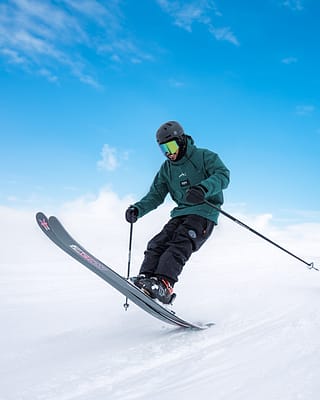How to ski switch
Unlock the power of skiing backwards! This is a big-time skill that will have you dominating the mountain, opening you up to a whole new set of ski skills.

Skiing switch is not only a fun technique to down the slope but will enable you to do multiple new tricks. If that was not enough to convince you to learn switch skiing, well it looks pretty damn cool as well!
Convinced yet? Good, let’s go!

The essential gear for the slopes
Progressing in your switch skiing adventure requires more than just skills and technique, choice of gear plays a pivotal role too. Our extensive range of high-performing outdoor wear is designed specifically to foster your transition from a novice to a switch skiing maestro, no matter how grand your skiing aspirations may be. Navigate through our meticulously curated collection offering ski pants for men and ladies ski pants. Harmonising style and functionality, these cold-weather solutions are created with an emphasis on comfort, safety and fashion. Kitted out appropriately, you'll be all set to command the mountain!
Skiing switch
Before we even start talking about skiing switch, you need to master skiing forward with turning and carving.
If you are looking to learn to switch skiing you probably already know all about skiing forwards, so let’s just turn it around! You should first find a gentle slope with almost no elevation. When you first start skiing switch you might be fearful of slowing down at first; So you don’t want to start learning on a slope where you gain speed fast.

Since you don’t have eyes in the back of your head, choosing which shoulder to look over is key to skiing switch safely. Beginners often switch between shoulders too often, which disrupts balance. Instead, commit to looking over one shoulder—most skiers naturally prefer their dominant side. However, for better versatility, practice looking over both shoulders to adapt to different turns and slopes.
You should also have a pair of twin-tip skis, you can ski switch with any ski, but a pair of twin-tip skis will make your life much easier when skiing switch.
The basic position is the same when you are skiing switch as when you are skiing forwards. Do not ski with your legs straight; you need to bend your knees and ankles.
When you start sliding backwards, it is important that you start your carving straight away. You do not want to slide backwards with you skis straight down the slope.
Carving switch
To get into the turn, slowly push your left foot backwards. This will position your left ski a bit further down the slope than your right ski.
Then slowly turn your hips to your left and let your shoulders follow. Then look over your left shoulder. Just like when you are skiing forwards, your weight should be on the ski that is outside of the turn. Your outer ski.
Why edge control is harder when skiing switch
When skiing forwards, you naturally have more power through your turns because your body weight leans into them. When skiing switch, it’s easier to lose edge pressure, making turns feel less stable. To counter this, focus on:
- Keeping ankles flexed to maintain good ski-to-snow contact.
- Rolling your knees gradually into turns instead of forcing them.
- Using your core for balance rather than just your legs, especially when transitioning from one turn to the next.
These small adjustments make a huge difference in stability when carving switch.
Have a look at this short and to-the-point video about switch skiing. Many of the pointers mentioned above are in this video.
To initiate another turn, you do it the same way as skiing forwards, a slight roll on the knees to the edge of your ski.
It is important that you practice this both ways from the beginning, so you do not end up only being able to ski switch on your left or right side.
So now repeat the process but the other way around.
Start slowly turning your hips towards the right, push back your right foot, let your shoulders follow, and look over your right shoulder. Be sure to move your weight to the right ski, which is now the outer ski.

Good to think about when skiing switch
Switch skiing feels unnatural at first because your body is used to facing forward. To speed up muscle memory, try these off-the-slopes exercises:
Balance drills – Stand on one leg and rotate your upper body like you would when skiing switch. This improves stability and coordination.
Core workouts – A strong core helps control movement when looking over your shoulder. Planks and rotational exercises are especially useful.
Ski simulation – On flat terrain, practice stepping into a switch skiing stance and mimicking turns before hitting a real slope.
Building these habits will make skiing switch feel more natural and controlled when you’re actually on the mountain.
Forget all about the fries and pizza principle when skiing switch. It will do more damage than good. If you are unfamiliar with this, the pizza is when you shape your skis like a V to slow down, and the fries are when you have your skis straight to go faster.
Instead of slowing down or speed check, scoot a bit to your side the same way you would do to spray your friend with snow while skiing forwards. But do it more subtly and backwards.

How to transition to forward skiing
When you want to turn from switch skiing to forward skiing, the most simple way is to turn around with both skis at the same time.
To do this, start turning your hips and shoulders towards the way you wish to turn. Then move your weight all the way to the tails of the skis. You will feel how your skis almost spin back on their own.
Once you have this technique locked down, you should start practising to do pop and Ollie 180s as a transition from switch skiing to forwards skiing.
Mastering the effortless spin-back
Instead of forcefully turning back forward, let your skis do the work by using momentum. As you start the transition, shift your weight slightly onto your tails and let the skis naturally guide the turn. The key is to stay relaxed—too much force can make the spin jerky, while a smooth weight transfer makes it seamless.
If you struggle with control, practice small 90-degree pivots before committing to a full spin back to forward skiing.

Once you are comfortable with skiing switch, start having fun and play around with it to progress more! Try pop or Ollie 180s as a transition from forward to switch skiing.
Once you have this unlocked, try the landing switch after hitting jumps and feel how a new world of skiing opens up for you!
FAQ
Which skiing techniques are not applicable when skiing switch?
The fries and pizza principle, a standard beginner's technique to control speed and direction, is not applicable when skiing switch. Instead, skiers are encouraged to perform side scoots to control speed while skiing switch.
What's the next step after mastering skiing switch?
After becoming comfortable with skiing switch, skiers can add fun and complexity by trying pop or Ollie 180s as transitions from forward to switch skiing. Mastering these moves opens up a new world of skiing tricks and techniques.
How can I stop smoothly when skiing switch?
Unlike skiing forward, where you can use a traditional hockey stop, stopping while skiing switch requires a reverse hockey stop. To do this, turn your skis perpendicular to the slope, press down on your uphill edges, and let friction slow you down. Practicing small controlled stops before attempting full-speed switch skiing will help build confidence.
Is skiing switch harder on my legs?
Yes, at first! Since your body is in a less natural position, different muscles are engaged, especially in your core and lower back. However, over time, your body will adapt, and skiing switch will feel just as easy as regular skiing.
Check out some more of our awesome skiing styles here!
Previous Lesson










